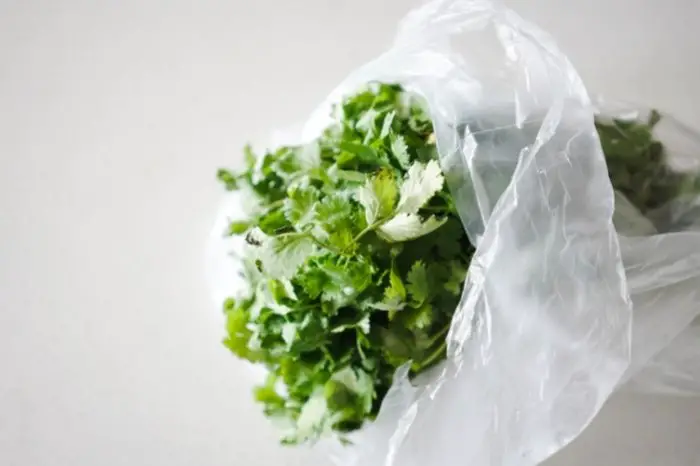Last Updated on August 9, 2022
Do you know how to cut cilantro or a guide on how to do it correctly will help you get some tips?
Cilantro is not only used in cooking but it is also considered a herb. Cilantro or coriander leaves are popular in many parts of the world and most especially in Asia and Europe.
Coriander is often seen in Asian dishes such as Vietnamese, Thai, Indian, and Chinese meals because this herb brings out the best flavors when combined with other ingredients.
Since cilantro grows fast and can easily be propagated by breaking apart clumps into smaller sections that contain one stem and several leaves, it can be grown in a home garden.
Both the leaves and stems of the cilantro plant are edible. The leaves are soft and tender, whereas the stems are fibrous and more flavorful.
How To Cut Cilantro From Plants?
If you want to know how to cut cilantro without killing the plant, here’s how:
Step 1: Select a stem on the periphery of the clump and cut it off using sharp kitchen shears. Cutting at this stage will remove only the stem and some leaves but not all. This method helps you harvest cilantro several times.
Step 2: After removing one stem, use your fingers to separate the remaining stems so you can find how to cut cilantro from a plant with ease. If there are no other stems visible anywhere in your garden, be sure to check again as they might still be hidden underneath larger leaves.
How To Cut Cilantro From The Garden?
Now that you know how to cut cilantro from plants, let’s learn how to correctly cut your cilantro leaves from the garden. Here is a step-by-step guide:
Step 1: Hold a stem firmly in one hand and a clean pair of scissors in the other.
Step 2: Cut cilantro stems right above a leaf node to retain most of your plants. A leaf node is where leaves are attached to the stem. Removing leaves below this area will seriously affect how to cut cilantro from the garden because it can disturb its growth pattern plus you’re left with shortened stems that won’t be as strong.
Step 3: Cut off your cilantro stems with a single clean cut to ensure you don’t damage the plant. Whatever you do, never cut your cilantro in a zigzag manner because this will tear the stem open and expose it to air which encourages its tissue to dry up.
Follow this how-to cut cilantro guide correctly and your garden will always be full of culinary delights!
Click here for A Guide To Growing Black Beauty Zucchini
How To Cut Cilantro Leaves In The Kitchen
Once you have harvested your cilantro, it’s time to learn how to cut cilantro leaves in the kitchen. Follow these steps to get it done easily:
Step 1: Start by washing your hands. Always handle your food with clean hands.
Step 2: Start pulling off the large outer leaves from the stems. Be sure to tear the leaves off instead of cutting with a knife.
Step 3: Once you have enough leaves pulled off, wash them with clean water to get off dirt and insects if any.
Joyoldelf Gourmet Herb Scissors Set
Step 4. Roll these leaves upholding them between your first three fingers. Place them flat on your cutting board and hold them firmly so they won’t move. Hold your knife with a comfortable grip, keeping it in one position. Slowly slice the how-to-cut cilantro leaves length.
Step 5: Cut these leaves into thin strips by holding your knife at an angle, about 30 degrees against the leafy pile. The thicker part of the cilantro leaves should be placed on top while the narrow end should be facing down towards your cutting board for stability.
Now you know how to cut your cilantro and get them ready to garnish your food.
Read more about How Does An Artichoke Grow?
How Long Does Cilantro Last After Harvesting?
Now that you know how to cut cilantro, you need to know that proper storage is important after harvesting.
Store your cut cilantro in a glass of water by covering it with a plastic bag and placing it on your refrigerator’s top shelf. Remember that cilantro tends to wilt fast so it’s best you only harvest what you need currently. If you want them to stay longer, you can also freeze the cilantro leaves inside baggies for up to six months.
If you’re cutting fresh cilantro leaves from your garden, don’t leave it out at room temperature even if it’s only one stem – never leave any food uncovered especially with how long cilantro lasts.

Conclusion – How To Cut Cilantro
After harvesting cilantro from your garden, always store them properly in the fridge. Cut the cilantro stems or leaves with a single clean cut to ensure you get perfect results every time.
Cilantro is a companion to every chef, as it has both health and medicinal properties that most people use. It can be used fresh or dry.
When used fresh, it has a very different taste than when it is dried. Fresh coriander leaves are an essential ingredient in many Asian dishes and American foods as well as Middle Eastern dishes.
Coriander has many health benefits which include its ability in helping to control diabetes. It also helps ease muscle pain and detoxifies the body when used topically or orally. In addition, it also lowers blood cholesterol levels, boosts good bacteria in your gut, and helps with digestion.
Happy gardening everyone!
FAQ’s
What part of cilantro do you cut?
There are many parts of cilantro you can cut. Different parts of how to cut cilantro can be used for different recipes.
Shallot - the white part that grows below the green leaves.
Green onion - the longest green stalk minus roots.
Root - it's actually how to cut cilantro from the plant so you have to dig up the plant first before harvesting this part.
Do you use the stems of cilantro?
Yes, cilantro stems are edible too. However, how to cut cilantro stems is not always efficient because it takes a lot of time and effort before you can make all those leaves come out.

Lory is an avid gardener who loves spending time outdoors. She is passionate about using her green thumb to create beautiful, lush gardens for her friends and family. She finds joy in tending to her garden, trimming plants, and cultivating new species. She loves to share her knowledge and experience with others who have a similar enthusiasm for gardening. Lory is a true nature enthusiast who loves to share her enthusiasm for the outdoors with all who meet her.

